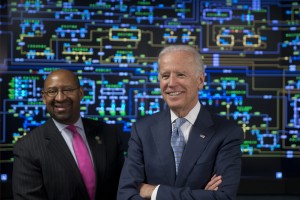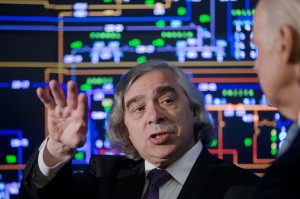Obama Administration proposes billions to overhaul energy infrastructure
-
Susan Phillips

Matt Rourke / AP Photo
Vice President Joe Biden, right, accompanied by Philadelphia Mayor Michael Nutter tours the headquarters of PECO energy company in Philadelphia, Tuesday. The White House has released the Quadrennial Energy Review, designed to modernize the nation’s energy infrastructure.
The Obama Administration wants to spend billions of dollars to upgrade the nation’s energy infrastructure. That means replacing pipelines, making the grid more resilient against terrorism or cyber attacks, preparing the systems for rising sea levels, improving data on crude-by-rail, reducing emissions from natural gas infrastructure, and modernizing the electrical grid.
The White House chose to roll out the first ever “Quadrennial Energy Review” in Philadelphia, which has struggled to keep pace with replacing its own aging natural gas pipes, and is trying to position itself as an East Coast “energy hub.”
Vice President Joe Biden and Energy Secretary Ernie Moniz toured a PECO Energy facility in Philadelphia Tuesday before speaking to area business leaders.
PECO received a $200 million dollar federal stimulus grant back in 2009 to upgrade its transmission system. The electric and gas utility serves a six-county area that includes Philadelphia and its suburbs.
This first Quadrennial Energy Review focuses exclusively on infrastructure and is part of President Obama’s Climate Action Plan.

Matt Rourke / AP Images
Energy Secretary Ernest Moniz, left, and Vice President Joe Biden tour the headquarters of PECO energy company in Philadelphia, Tuesday, April 21, 2015.
Vice President Joe Biden told those assembled at PECO headquarters that it’s meant to address both climate change and the nation’s booming energy industry.
“The United States is in the midst of an energy transformation that will allow us to remain the energy epicenter of the world in the 21st century,” said Biden. “But to maintain that position we need a 21st Century infrastructure.”
Biden said that systems in place to transport energy from its source to the power plants, and eventually to homes and businesses, need a major overhaul.
“It involves complex networks, and pipelines, transmission lines, storage facilities above and below ground and it’s increasingly outdated, much of it built decades ago,” he said.
The Administration’s proposals would cost between about $13 billion to $15.5 billion in new spending and tax breaks. It includes $2.5 to $3.5 billion for states to help replace aging natural gas distribution lines.
















